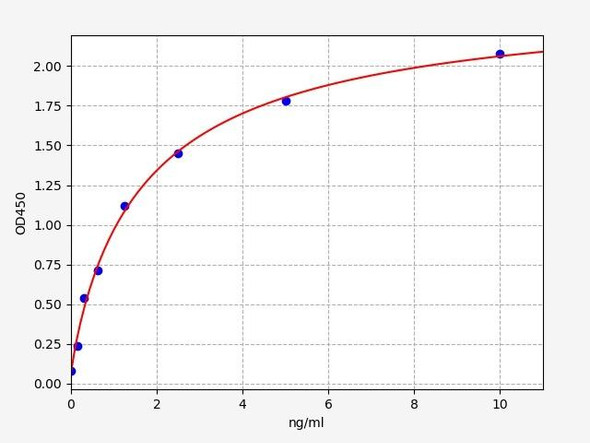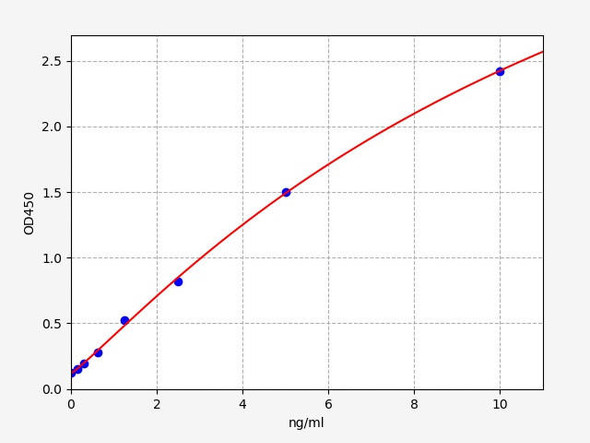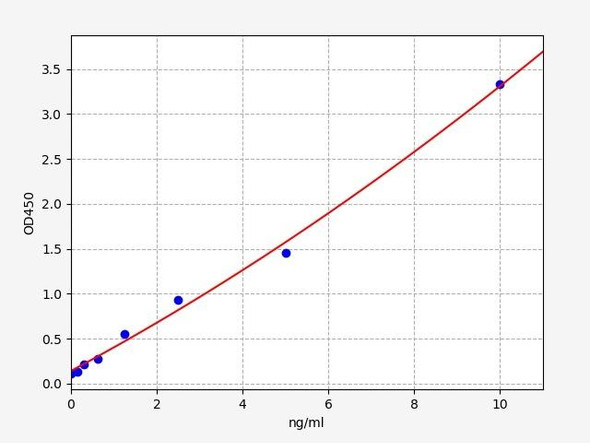Mouse Cell Biology ELISA Kits
Mouse MBP (Myelin Basic Protein) ELISA Kit (MOES01280)
- SKU:
- MOES01280
- Product Type:
- ELISA Kit
- Size:
- 96 Assays
- Uniprot:
- P04370
- Sensitivity:
- 0.09ng/mL
- Range:
- 0.16-10ng/mL
- ELISA Type:
- Sandwich
- Synonyms:
- Myelin_MBP
- Reactivity:
- Mouse
- Sample Type:
- Serum, plasma and other biological fluids
Description
| Assay type: | Sandwich |
| Format: | 96T |
| Assay time: | 4.5h |
| Reactivity: | Mouse |
| Detection Method: | Colormetric |
| Detection Range: | 0.16-10 ng/mL |
| Sensitivity: | 0.10 ng/mL |
| Sample Volume Required Per Well: | 100µL |
| Sample Type: | Serum, plasma and other biological fluids |
| Specificity: | This kit recognizes Mouse MBP in samples. No significant cross-reactivity or interference between Mouse MBP and analogues was observed. |
This ELISA kit uses Sandwich-ELISA as the method. The micro ELISA plate provided in this kit has been pre-coated with an antibody specific to Mouse MBP. Standards or samples are added to the appropriate micro ELISA plate wells and combined with the specific antibody. Then a biotinylated detection antibody specific for Mouse MBP and Avidin-Horseradish Peroxidase (HRP) conjugate are added to each micro plate well successively and incubated. Free components are washed away. The substrate solution is added to each well. Only those wells that contain Mouse MBP, biotinylated detection antibody and Avidin-HRP conjugate will appear blue in color. The enzyme-substrate reaction is terminated by adding Stop Solution and the color turns yellow. The optical density (OD) is measured spectrophotometrically at a wavelength of 450 nm ± 2 nm. The OD value is proportional to the concentration of Mouse MBP. The concentration of Mouse MBP in samples can be calculated by comparing the OD of the samples to the standard curve.
| UniProt Protein Function: | Function: The classic group of MBP isoforms (isoform 4-isoform 13) are with PLP the most abundant protein components of the myelin membrane in the CNS. They have a role in both its formation and stabilization. The non-classic group of MBP isoforms (isoform 1-isoform 3/Golli-MBPs) may preferentially have a role in the early developing brain long before myelination, maybe as components of transcriptional complexes, and may also be involved in signaling pathways in T-cells and neural cells. Differential splicing events combined to optional post-translational modifications give a wide spectrum of isomers, with each of them potentially having a specialized function. 1 PublicationManual assertion based on experiment in:Ref. 17 |
| NCBI Summary: | The protein encoded by the classic Mbp gene is a major constituent of the myelin sheath of oligodendrocytes and Schwann cells in the nervous system. However, Mbp-related transcripts are also present in the bone marrow and the immune system. These mRNAs arise from the long Mbp gene (otherwise called "Golli-Mbp") that contains 3 additional exons located upstream of the classic Mbp exons. Alternative splicing from the Golli and the Mbp transcription start sites gives rise to 2 sets of Mbp-related transcripts and gene products. The Golli mRNAs contain 3 exons unique to Golli-Mbp, spliced in-frame to 1 or more Mbp exons. They encode hybrid proteins that have N-terminal Golli aa sequence linked to Mbp aa sequence. The second family of transcripts contain only Mbp exons and produce the well characterized myelin basic proteins. This complex gene structure is conserved among species suggesting that the Mbp transcription unit is an integral part of the Golli transcription unit and that this arrangement is important for the function and/or regulation of these genes. Mutation of the Mbp gene is associated with the 'shiverer' and 'myelin deficient' phenotypes in mouse. [provided by RefSeq, Jul 2008] |
| UniProt Code: | P04370 |
| NCBI GenInfo Identifier: | 69885018 |
| NCBI Gene ID: | 17196 |
| NCBI Accession: | NP_001020416. 1 |
| UniProt Secondary Accession: | P04370,Q01585, Q03139, Q03176, Q61836, Q61837, Q99KE4 Q9QWP1, |
| UniProt Related Accession: | P04370 |
| Molecular Weight: | 27,168 Da |
| NCBI Full Name: | Golli-Mbp isoform 2 |
| NCBI Synonym Full Names: | myelin basic protein |
| NCBI Official Symbol: | Mbp |
| NCBI Official Synonym Symbols: | mld; shi; Hmbpr; C76307; R75289; golli-mbp |
| NCBI Protein Information: | Golli-Mbp; myelin basic protein; shiverer; myelin deficient; myelin A1 protein |
| UniProt Protein Name: | Myelin basic protein |
| UniProt Synonym Protein Names: | Myelin A1 protein |
| Protein Family: | Myelin basic protein |
| UniProt Gene Name: | Mbp |
| UniProt Entry Name: | MBP_MOUSE |
As the OD values of the standard curve may vary according to the conditions of the actual assay performance (e. g. operator, pipetting technique, washing technique or temperature effects), the operator should establish a standard curve for each test. Typical standard curve and data is provided below for reference only.
| Concentration (ng/mL) | O.D | Average | Corrected |
| 10 | 2.408 2.442 | 2.425 | 2.357 |
| 5 | 1.693 1.715 | 1.704 | 1.636 |
| 2.5 | 1.029 1.011 | 1.02 | 0.952 |
| 1.25 | 0.532 0.55 | 0.541 | 0.473 |
| 0.63 | 0.293 0.277 | 0.285 | 0.217 |
| 0.32 | 0.18 0.176 | 0.178 | 0.11 |
| 0.16 | 0.118 0.13 | 0.124 | 0.056 |
| 0 | 0.063 0.073 | 0.068 | -- |
Precision
Intra-assay Precision (Precision within an assay): 3 samples with low, mid range and high level Mouse MBP were tested 20 times on one plate, respectively.
Inter-assay Precision (Precision between assays): 3 samples with low, mid range and high level Mouse MBP were tested on 3 different plates, 20 replicates in each plate.
| Intra-assay Precision | Inter-assay Precision | |||||
| Sample | 1 | 2 | 3 | 1 | 2 | 3 |
| n | 20 | 20 | 20 | 20 | 20 | 20 |
| Mean (ng/mL) | 0.54 | 0.92 | 3.70 | 0.54 | 0.95 | 4.02 |
| Standard deviation | 0.03 | 0.05 | 0.18 | 0.03 | 0.04 | 0.13 |
| C V (%) | 5.56 | 5.43 | 4.86 | 5.56 | 4.21 | 3.23 |
Recovery
The recovery of Mouse MBP spiked at three different levels in samples throughout the range of the assay was evaluated in various matrices.
| Sample Type | Range (%) | Average Recovery (%) |
| Serum (n=5) | 91-104 | 96 |
| EDTA plasma (n=5) | 95-106 | 100 |
| Cell culture media (n=5) | 87-97 | 92 |
Linearity
Samples were spiked with high concentrations of Mouse MBP and diluted with Reference Standard & Sample Diluent to produce samples with values within the range of the assay.
| Serum (n=5) | EDTA plasma (n=5) | Cell culture media (n=5) | ||
| 1:2 | Range (%) | 86-96 | 97-115 | 93-108 |
| Average (%) | 91 | 105 | 100 | |
| 1:4 | Range (%) | 88-105 | 87-99 | 86-100 |
| Average (%) | 96 | 92 | 91 | |
| 1:8 | Range (%) | 91-104 | 85-98 | 85-97 |
| Average (%) | 96 | 92 | 90 | |
| 1:16 | Range (%) | 90-100 | 83-93 | 86-97 |
| Average (%) | 95 | 87 | 92 |
An unopened kit can be stored at 4°C for 1 month. If the kit is not used within 1 month, store the items separately according to the following conditions once the kit is received.
| Item | Specifications | Storage |
| Micro ELISA Plate(Dismountable) | 8 wells ×12 strips | -20°C, 6 months |
| Reference Standard | 2 vials | |
| Concentrated Biotinylated Detection Ab (100×) | 1 vial, 120 µL | |
| Concentrated HRP Conjugate (100×) | 1 vial, 120 µL | -20°C(shading light), 6 months |
| Reference Standard & Sample Diluent | 1 vial, 20 mL | 4°C, 6 months |
| Biotinylated Detection Ab Diluent | 1 vial, 14 mL | |
| HRP Conjugate Diluent | 1 vial, 14 mL | |
| Concentrated Wash Buffer (25×) | 1 vial, 30 mL | |
| Substrate Reagent | 1 vial, 10 mL | 4°C(shading light) |
| Stop Solution | 1 vial, 10 mL | 4°C |
| Plate Sealer | 5 pieces | |
| Product Description | 1 copy | |
| Certificate of Analysis | 1 copy |
- Set standard, test sample and control (zero) wells on the pre-coated plate and record theirpositions. It is recommended to measure each standard and sample in duplicate. Note: addall solutions to the bottom of the plate wells while avoiding contact with the well walls. Ensuresolutions do not foam when adding to the wells.
- Aliquot 100µl of standard solutions into the standard wells.
- Add 100µl of Sample / Standard dilution buffer into the control (zero) well.
- Add 100µl of properly diluted sample (serum, plasma, tissue homogenates and otherbiological fluids) into test sample wells.
- Cover the plate with the sealer provided in the kit and incubate for 90 min at 37°C.
- Aspirate the liquid from each well, do not wash. Immediately add 100µL of BiotinylatedDetection Ab working solution to each well. Cover the plate with a plate seal and gently mix. Incubate for 1 hour at 37°C.
- Aspirate or decant the solution from the plate and add 350µL of wash buffer to each welland incubate for 1-2 minutes at room temperature. Aspirate the solution from each well andclap the plate on absorbent filter paper to dry. Repeat this process 3 times. Note: a microplatewasher can be used in this step and other wash steps.
- Add 100µL of HRP Conjugate working solution to each well. Cover with a plate seal andincubate for 30 min at 37°C.
- Aspirate or decant the solution from each well. Repeat the wash process for five times asconducted in step 7.
- Add 90µL of Substrate Reagent to each well. Cover with a new plate seal and incubate forapproximately 15 min at 37°C. Protect the plate from light. Note: the reaction time can beshortened or extended according to the actual color change, but not by more than 30min.
- Add 50 µL of Stop Solution to each well. Note: Adding the stop solution should be done inthe same order as the substrate solution.
- Determine the optical density (OD value) of each well immediately with a microplate readerset at 450 nm.






